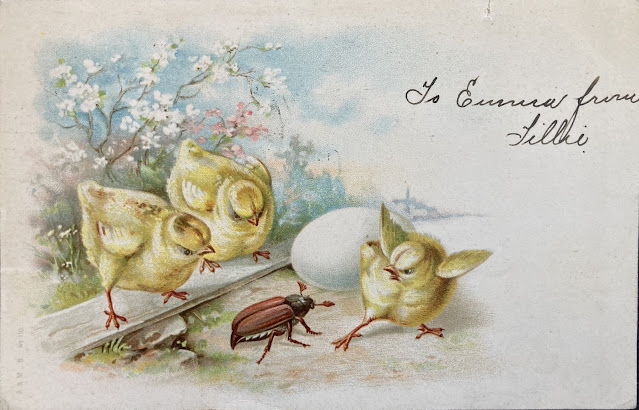Postcards Galore! Part I
I'm having a lot of fun participating in Thursday Postcard Hunt, and collecting postcards! So much so I decided to share some posts about postcards in general and some of mine. A beginner's beginning guide by a beginner. Sort of like I did with salt and pepper shakers last year.* Hmmm... seems it was almost exactly a year ago. End of summer boredom?
So, let's get started! Any information and dates are based on U.S. postcards. All photos are of my own postcards.
Did you know a person who collects and or studies postcards is deltiologist? That was new to me. The term has only been around since 1945, when professors at Ohio University wanted a "scholarly" name for the postcard collecting hobby! "Deltion" is Greek for a small illustrated tablet or card. I guess they were embarrassed by their hobby? No reason to be, it's the third most popular collecting hobby in the U.S.
Postcard is the accepted spelling now, however on most older cards it was two words, Post Card. But, Post Card was not printed on the cards until December 24, 1901. Prior to that it was the Private Mailing Card Period. In May, 1898 Congress granted permission for publishers to print their own postcards (the government issued all post cards before this), and they qualified for a 1¢ postage rate. Postcards were printed with "Private Mailing Card" and "Authorized by Act of Congress of May 19, 1898." Messages were not allowed on the address side of the card. The law was rescinded in 1901 and Postcard or Post Card could be used without the Authorized notice.
 |
| Private Mailing Card - 1903 postmark |

These early postcards had an undivided back (UDB), which lasted from 1901 to March of 1907. They often included the reminder to only use the stamp side for the address. Naturally, this is the Undivided Back Period. Some had a bit of room, or a dedicated area, for messages, but they had to be brief.
 |
| Undivided Back - 1904 postmark |
 |
| 1904 postmark |
 |
| ©1901, postmark 1907 |
One of my favorite UDB Postcards is this one, postmarked 1907, advertising Burnet Music, sheet music composed by Burnet Tuthill. It was sent to the hamlet of Altmar, N.Y., which even in 2010 only had a few hundred residents.
 |
I wonder how long the postcard took to be delivered to the waiting Mrs. Pray? Maybe in those days of horse drawn travel you came to expect delays and not worry so much if your expected visitors didn't show.
In 1907 it took another act of Congress to allow messages on the left half of the address side of privately produced cards, which remains the standard today. This is the Divided Back Period, or The Golden Age of Postcards. Postcards were particularly popular with rural and small town women in the Northern U.S. The expansion of free postal deliver to rural areas helped increase their use. Postcards were so popular that 700 million were sent in just the year ending July 30, 1908! The Golden Age lasted until 1915, when WWI brought change to not only the world, but postcards.
 |
| Divided Back - 1908 postmark |
 |
| Divided Back - 1908 postmark |
 |
| White Border - c1920s-1930s |
* the salt and pepper posts
https://lisasgardenadventureinoregon.blogspot.com/2023/07/salt-and-pepper-shakers-my-collection.html
https://lisasgardenadventureinoregon.blogspot.com/2023/07/salt-and-pepper-shakers-collecting.html
#postcardcollecting #deltiologist #deltiology #postcards #collectingpostcards #postcardcollection




Wow, I did not know any of that. Fascinating.
ReplyDeleteI think so! :)
DeleteThat is a great postcard history post. All the postcard you show in this post are so beautiful. The piggies and the horse ones are my favorite.
ReplyDeleteI like the horse one a lot, because of the dog! Although I do love horses. I have quite a few antique piggie cards. They must have been a "thing." They all have some sort of pun.
Delete